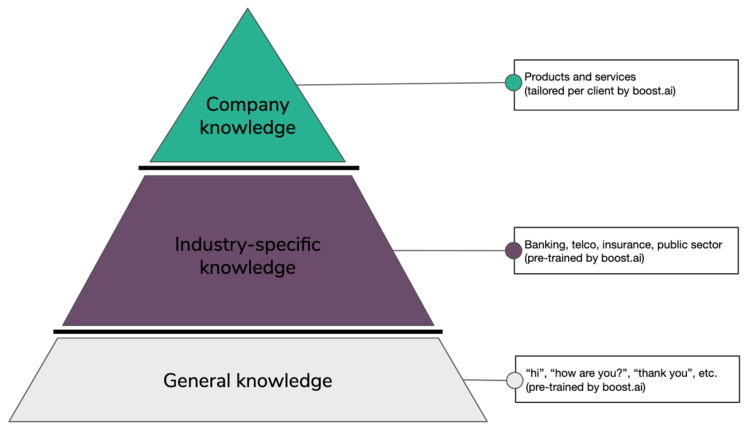Conversational AI is estimated to grow into a $15.7 billion market by 2024. Along with this incredible growth, however, come challenges such as being able to effectively navigate a crowded vendor landscape. Most of the confusion for companies looking to adopt a conversational AI solution stems from a misunderstanding of what technology is out there and how it can be used to improve customer experience.
Presently, the market is flooded with rule-based chatbots. These are the kind of interactive chat experiences that became popular on platforms like Facebook but which, ultimately, are quite limited in their scope. They offer no genuine artificial intelligence and, instead, rely on buttons to drive a conversation forward, rather than natural language technologies that more accurately reflect the way we, as humans, communicate. Chatbots gained prominence in the market due to their simplicity to build but, while they can be helpful in use cases such as booking a restaurant reservation or ordering a bouquet of flowers, they quickly break down as a business’ needs begin to scale up. Gartner predicts that in 2020, 40% of chatbot projects started in 2018 will be abandoned. Many of these will likely be rule-based chatbots that didn’t deliver on the promise of conversational customer experience due to an inability to effectively scale up.
Prior experience with an unsuccessful chatbot project is what has led many businesses to search for what comes next. They see the potential in the technology but also realize that genuine artificial intelligence is crucial to being able to deliver a level of customer service that is not only on par with existing support channels but one that can move the needle far beyond them. This is where conversational AI-powered virtual agents have begun to take over from the inefficient chatbots of the previous decade and stand to disrupt customer service paradigms as we move into 2020 and beyond.
An enterprise-ready feature set
In the enterprise space, online customer interactions run the gamut from simple informational queries to complex transactions that require multiple API calls to third-party and backend systems. Conversational AI is built from the ground up as an enterprise solution to effectively handle these extreme variations in customer intent.
Some of the advanced enterprise functionality that sets conversational AI apart from rule-based chatbots includes:
- Superior language understanding via NLU and Deep Learning algorithms
- Simultaneous multilingual support
- Contextual-awareness to carry on a conversation even if it has veered off-track
- Advanced spelling correction and support for slang and dialects
- The ability to set conversation goals and clearly track customer engagement
- Integration with backend systems and third-party platforms (i.e. Genesys, Salesforce, etc.)
- User authentication to allow transactions to be completed on behalf of customers
- Strict data security and privacy features, including compliance with GDPR
Conversational AI is also designed as a tool to help augment existing support staff and not only assist customers. If a virtual agent is stumped by a request that is outside of its designated scope, it is able to seamlessly handover a customer to a human chat operator all within the same chat window.
A centralized hub of knowledge
A dedicated set of features and functionality are a key component of what sets conversational AI above simple rule-based chatbots in the enterprise space. However, a crucial piece of the puzzle in delivering the highest-level customer experience possible actually lies in the body of data that a vendor uses to build a virtual agent from the ground up.
Many of the larger vendors offering conversational AI solutions take a generalized approach to their knowledge corpus. While this may sound appealing initially, tapping into the existing data of a tech giant’s customer base can prove to be too broad of an approach for a bank or insurance company. This ‘jack of all trades, master of none’ strategy may work for projects with a smaller scope, but once customers begin asking deeper questions about your products and services you’ll quickly find that being able to answer general trivia about Star Wars isn’t going to cut it.

Instead, boost.ai has developed a three-pronged approach to building up a holistic knowledge corpus for each client that we call the ‘Three levels of conversational AI knowledge’:
- General knowledge
- e.g. “hi”, “how are you?”, “thank you”, etc.
- Industry-specific knowledge
- e.g. banking, telco, insurance, public sector, etc.
- Company knowledge
- e.g. brand-specific products and services
The first two - industry-specific and general knowledge - are pre-built based on our unique experience of having successfully launched 150+ virtual agents across multiple industries. They include intents numbering in the thousands, unlike many off-the-shelf solutions that claim to have only a few hundred at the most.
Other vendors may offer ‘templates’ for different verticals but, like a rented tuxedo, they are often ill-fitting and don’t hold up upon closer scrutiny. To deliver a virtual agent that truly elevates customer experience, you need to go beyond general-level industry intents and deliver a data set that has been specifically designed with each market in mind - including common terminology, use cases and more.
Starting with this solid foundation allows a company to kickstart its virtual agent project with confidence and with all the intents it needs to generally succeed in its particular sector. It also means that no superfluous or unnecessary data from other verticals clogs up the model.
Of course, every company also has its own unique nomenclature that is critically important for a virtual agent to be able to accurately reflect. Company-specific terms are not automatically covered in the vast knowledge corpora of the larger tech companies. Anyone who has tried using Google Translate on domain-specific documents can attest to just how messy the results can be. That means a company needs to spend additional time and resources adding this data itself, and in some cases, it can’t be done without engaging highly-skilled (and costly) technical staff.
Much like you would visit a tailor to purchase a bespoke suit that fits you perfectly, at boost.ai, we work closely with each of our clients to build a unique model that includes company-specific terms and concepts and is tailored to their own products, services and brand culture.
To develop this top data layer, we use our conversational AI to parse through a company’s existing live chat logs letting it identify new intents that can be used to enrich the model. Once the virtual agent goes into production, conversational AI continues suggesting additional new intents based on its interactions with customers that are then approved and added by the human AI trainers whose job it is to continually maintain and improve the virtual agent.
Next-level understanding
This approach is a big part of what differentiates our conversational AI from typical plug-and-play chatbot solutions. However, it’s not simply enough to have a data set designed explicitly for your company if your virtual agent isn’t able to accurately put it to good use.
This is why we have developed a proprietary algorithm called Automatic Semantic Understanding (ASU) that greatly enhances the language understanding capabilities of conversational AI. ASU gives our virtual agents a competitive edge in understanding the underlying intent of a customer’s query by finding complicated connections between sentences. It allows a virtual agent to understand the meaning of any user input - even sentences with multiple intents - and removes dead ends from conversations by drastically reducing the likelihood of false positives.
Rather than applying ASU across our knowledge corpus in its entirety, we instead apply it to each model we build for our clients independently. This results in a smarter virtual agent that doesn’t miss out on the subtle nuances in an interaction that are important for it to understand. For instance, a banking virtual agent with ASU may interpret the term ‘MC’ in a variety of ways - i.e. either as ‘MasterCard’ or ‘Motorcycle’. This is unnecessary in a telco virtual agent that has no need to understand anything related to motorcycles, and therefore, thanks to ASU, will only interpret ‘MC’ in relation to payment inquiries.
By activating the ASU algorithm only once each client’s model has been sufficiently trained, we can ensure a consistent baseline of understanding that is bespoke to each virtual agent. This way, your virtual agent can confidently tackle customer inquiries that are unique to your business with a level of accuracy that is otherwise unrivaled by any other solution on the market.
